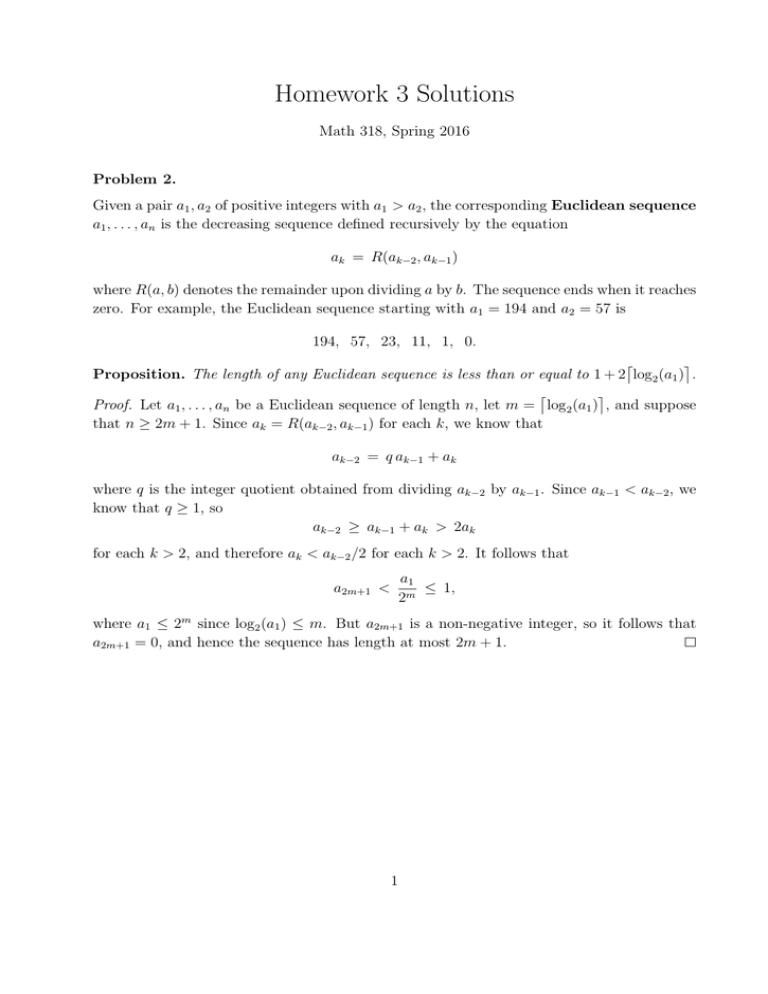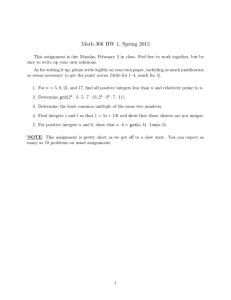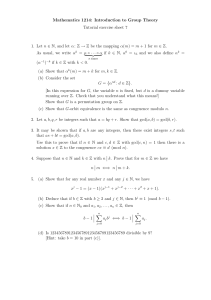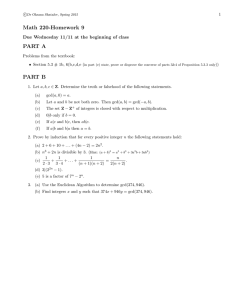Homework 3 Solutions
advertisement

Homework 3 Solutions
Math 318, Spring 2016
Problem 2.
Given a pair a1 , a2 of positive integers with a1 > a2 , the corresponding Euclidean sequence
a1 , . . . , an is the decreasing sequence defined recursively by the equation
ak = R(ak−2 , ak−1 )
where R(a, b) denotes the remainder upon dividing a by b. The sequence ends when it reaches
zero. For example, the Euclidean sequence starting with a1 = 194 and a2 = 57 is
194, 57, 23, 11, 1, 0.
Proposition. The length of any Euclidean sequence is less than or equal to 1 + 2 log2 (a1 ) .
Proof. Let a1 , . . . , an be a Euclidean sequence of length n, let m = log2 (a1 ) , and suppose
that n ≥ 2m + 1. Since ak = R(ak−2 , ak−1 ) for each k, we know that
ak−2 = q ak−1 + ak
where q is the integer quotient obtained from dividing ak−2 by ak−1 . Since ak−1 < ak−2 , we
know that q ≥ 1, so
ak−2 ≥ ak−1 + ak > 2ak
for each k > 2, and therefore ak < ak−2 /2 for each k > 2. It follows that
a1
≤ 1,
2m
a2m+1 <
where a1 ≤ 2m since log2 (a1 ) ≤ m. But a2m+1 is a non-negative integer, so it follows that
a2m+1 = 0, and hence the sequence has length at most 2m + 1.
1
Problem 3.
If a is a positive integer and p is a prime, the multiplicity of p in a is defined by the
formula
np (a) = max{k | pk divides a}.
Part (a)
Proposition. If a, b, and c are positive integers, then
lcm(a, b, c) =
abc gcd(a, b, c)
gcd(a, b) gcd(a, c) gcd(b, c)
Proof. It suffices to prove that
np abc gcd(a, b, c) = np lcm(a, b, c) gcd(a, b) gcd(a, c) gcd(b, c) .
for any prime p. If we let A = np (a), B = np (a), and C = np (c), then this equation can be
written
A + B + C + min(A, B, C) = max(A, B, C) + min(A, B) + min(A, C) + min(B, C). (∗)
To prove this, suppose without loss of generality that A ≤ B ≤ C. Then the left side of
equation (∗) is equal to A + B + C + A, and the right side is C + A + A + B, so the two
sides are equal.
Part (b)
Proposition. If a, b, and c are positive integers, then
lcm a, gcd(b, c) = gcd lcm(a, b), lcm(a, c)
Proof. It suffices to prove that
np lcm a, gcd(b, c) = np gcd lcm(a, b), lcm(a, c)
for any prime p. If we let A = np (a), B = np (a), and C = np (c), then this equation can be
written
max A, min(B, C) = min max(A, B), max(A, C) .
(∗)
To prove this, suppose without loss of generality that B ≤ C. Then the left side of equation (∗) is simply max(A, B). But since max(A, B) ≤ max(A, C), the right side is also equal
to max(A, B), so the two sides are equal.
2







